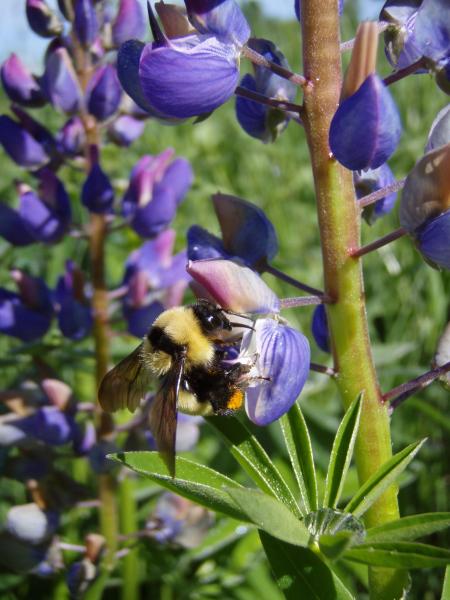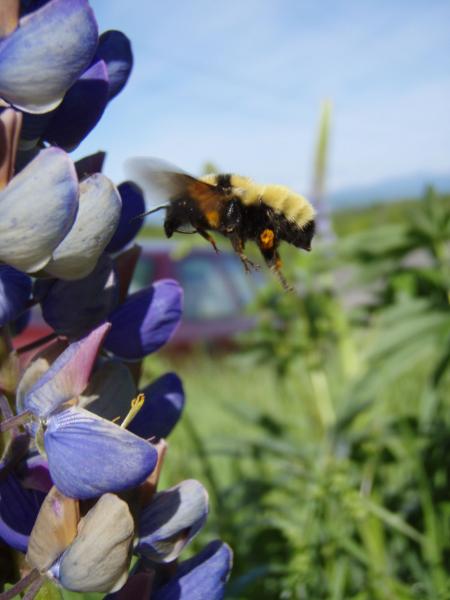Yellow Bumble Bee
Bombus fervidus (Fabricius, 1798)
- Class
- Insecta (Insects)
- Family
- Apidae (Triepeolus)
- State Protection
- Not Listed
Not listed or protected by New York State.
- Federal Protection
- Not Listed
- State Conservation Status Rank
- S3
Vulnerable in New York - Vulnerable to disappearing from New York due to rarity or other factors (but not currently imperiled); typically 21 to 80 populations or locations in New York, few individuals, restricted range, few remaining acres (or miles of stream), and/or recent and widespread declines.
- Global Conservation Status Rank
- G3G4
Vulnerable globally, or Apparently Secure - At moderate risk of extinction, with relatively few populations or locations in the world, few individuals, and/or restricted range; or uncommon but not rare globally; may be rare in some parts of its range; possibly some cause for long-term concern due to declines or other factors. More information is needed to assign either G3 or G4.
Summary
Did you know?
Yellow Bumble Bees are a long-tongued bee species (Colla et al. 2011). Due to this, they prefer different flowers as nectar sources than short-tongued bee species, such as red clover and Delphinium (Schweitzer et al. 2012).
State Ranking Justification
While there is evidence from museum records that the Yellow Bumble Bee had suffered a rapid, recent decline in NY (Richardson 2013 and Yanega 2013), the species appears to have rebounded, as evidenced by a statewide survey 2017-2021. Various threats continue to face this species including habitat loss, insecticides, and urbanization (Schweitzer et al. 2012). Based on data from the Empire State Native Pollinator Survey, the current (2000 to present) and historical (1999 and earlier) distribution in NY has remained relatively stable. This species appears to have a stronghold in New York City and the Hudson Valley, and Long Island, and there are also populations in several counties statewide (White et al. 2022).
Short-term Trends
The short-term trends for this species are unknown.
Long-term Trends
Based on data from the Empire State Native Pollinator Survey, the current (2000 to present) and historical (1999 and earlier) distribution in NY has remained relatively stable. While there are some counties no longer occupied that were historically, there are also several new county records in recent years (White et al. 2022).
Conservation and Management
Threats
The primary threat to species in the subgenus Thoracobombus leading to their rapid, recent decline in the 1990s has been attributed to exotic pathogens. Cameron et al. (2011) showed a higher proportion of Thoracobombus individuals infected by the pathogen Nosema bombi than other bumble bees with stable global populations. While there is evidence from museum records that this species had a precipitous decline in NY (Richardson 2013 and Yanega 2013), the species appears to have rebounded, as evidenced by a statewide survey 2017-2021. Various other threats continue to face this species including habitat loss, insecticides, and urbanization (Schweitzer et al. 2012).
Conservation Strategies and Management Practices
Any efforts to protect wild bumble bee populations from pathogen exposure would benefit Yellow Bumble Bees. Suggested actions would include using mesh to prevent escape of bees from commercial breeding greenhouses, proper disposal of commercial bees, sanitation in greenhouses, and development of molecular screening. Tight restrictions on importing bumble bees and elimination of parasites from commercial populations has been suggested as ideal (Meeus et al. 2011, Schweitzer et al. 2012).
Limiting exposure of Yellow Bumble Bee to insecticides would also benefit them. Suggested actions include avoidance of application to flowers that bumble bees are attracted to and application of solutions or soluble powders (rather than dusts or wettable powders) to the ground in calm wind and warmer temperatures during periods of dewless nights to minimize the impact to resident bumble bee populations (Schweitzer et al. 2012). Organic farming has also been suggested to benefit bumble bees.
Ensuring habitat resources for foraging, nesting, and overwintering will also benefit B. fervidus. Habitats for these needs should be within close proximity to each other and without road or railroads between them, which have been suggested as potential barriers to dispersal. Suggested actions for habitat management should include ensuring nectar availability throughout the spring and summer by improving flower abundance and species richness and species with overlapping blooms. Select food plants for B. fervidus include vetches, clovers, thistles, honeysuckles, bee balms, Penstemon, and Lythrum (Colla et al. 2011). If mowing of fields occurs, summer is the best time and mower blades should be raised to avoid ground nests. Staggering cutting times in different field areas will ensure nectaring sources are always available. Increasing available nesting habitat may be accomplished by reducing tillage in fields, leaving unplowed strips vegetated, or even providing artificial nesting boxes. Managing for rodents and ground-nesting birds should also benefit bumble bees (Schweitzer et al. 2012).
Research Needs
Further research is needed to determine more information on habitat requirements, threats, climate change effects, and insecticide effects for Yellow Bumble Bee.
Habitat
Habitat
Bumble bees are generalist foragers and need nesting habitat in the spring, flowers for adult and larval nutrition throughout the spring and summer, and sites for queens to overwinter. This bumble bee nests above ground and underground (Colla et al. 2011). Such species often use long grass or hay stacks above ground or abandoned rodent nests underground in south facing exposures. Foraging habitat should include flower abundance and species richness with overlapping blooms to ensure nectar availability throughout the growing season (Schweitzer et al. 2012). Select food plants for B. fervidus include vetches, clovers, honeysuckles, thistles, bee balms, Penstemon, and Lythrum (Colla et al. 2011). Suitable sites for bumble bees to overwinter may include rotting logs, mulch, or loose soil (Schweitzer et al. 2012).
Range
New York State Distribution
While there is evidence from museum records that the Yellow Bumble Bee had suffered a rapid, recent decline in NY (Richardson 2013 and Yanega 2013), the species appears to have rebounded, as evidenced by a statewide survey 2017-2021. Various threats continue to face this species including habitat loss, insecticides, and urbanization (Schweitzer et al. 2012). Based on data from the Empire State Native Pollinator Survey, the current (2000 to present) and historical (1999 and earlier) distribution in NY has remained relatively stable. This species appears to have a stronghold in New York City and the Hudson Valley, and Long Island, and there are also populations in several counties statewide (White et al. 2022).
Global Distribution
The Yellow Bumble Bee range includes the Canadian maritimes west to southern British Columbia and in the northeastern U.S. south to Georgia and to the west coast (NatureServe 2023).
Identification Comments
Identifying Characteristics
Yellow Bumble Bee queens and workers have black faces and yellow hair on the thorax with a black band between the wing bases. Abdominal segments one through four are yellow and segments five and six are black. Males have similar coloration to females, with black hair on the last two abdominal segments (Colla et al. 2011).
Best Time to See
Bumble bee queens hibernate over the winter, emerge in the spring, locate a nest site, and rear young (workers, males, and new queens). After new queens and males mate, all males, workers, and old queens die by the beginning of winter and new queens settle into sites to overwinter (Schweitzer et al. 2012).
- Active
- Reproducing
The time of year you would expect to find Yellow Bumble Bee active and reproducing in New York.
Similar Species
- Northern Amber Bumble Bee (Bombus borealis)
(guide)
Northern Amber Bumble Bee faces are yellow, while Yellow Bumble Bee faces are black (Colla et al. 2011).
Yellow Bumble Bee Images
Taxonomy
Yellow Bumble Bee
Bombus fervidus (Fabricius, 1798)
- Kingdom Animalia
- Phylum Arthropoda
(Mandibulates)
- Class Insecta
(Insects)
- Order Hymenoptera
(Bees, Wasps, Ants, Sawflies)
- Family Apidae (Triepeolus)
- Order Hymenoptera
(Bees, Wasps, Ants, Sawflies)
- Class Insecta
(Insects)
- Phylum Arthropoda
(Mandibulates)
Additional Resources
References
Bachman, S., J. Moat, A. Hill, J. de la Torre, and B. Scott. 2011. Supporting red list threat assessments with GeoCAT: geospatial conservation assessment tool. In: Smith, V. and L. Penev (Eds) e-Infrastructures for data publishing in biodiversity science. ZooKeys 150: 117-126. (Version BETA). Available online at: https://www.kew.org/science/our-science/projects/geocat-geospatial-conservation-assessment-tool.
Cameron, S.A., J.D. Lozier, J.P. Strange, J.B. Koch, N. Cordes, L.F. Solter, and T.L. Griswold. 2011. Patterns of widespread decline in North American bumble bees. PNAS. 108 (2): 662-667.
Colla, S. R., F. Gadallah, L. Richardson, D. Wagner, and L. Gall. 2012. Assessing declines of North American bumble bees (Bombus spp.) using museum specimens. Biodiversity and Conservation 21:3585–3595.
Colla, S., L. Richardson, and P. Williams. 2011. Bumble bees of the eastern United States.
Meeus, I., Brown, M.J.F., DeGraaf, D.C., and G. Smagghe. 2011. Effects of invasive parasites on bumble bee declines. Conservation Biology 25(4): 662-671.
NatureServe. 2023. NatureServe Network Biodiversity Location Data accessed through NatureServe Explorer [web application]. NatureServe, Arlington, Virginia. Available https://explorer.natureserve.org/.
New York Natural Heritage Program. 2024. New York Natural Heritage Program Databases. Albany, NY.
Richardson, L. 2013. Compilation of specimen records for Bombus species of North America from the American Museum of Natural History, Harvard Museum of Comparative Zoology, among several other museums. Unpublished data.
Schweitzer, D. and N. Sears. May 1, 2013. Bumble bee ranking guidelines. NatureServe, Arlington, VA.
Schweitzer, D.F., N.A. Capuano, B.E. Young and S.R. Colla. 2012. Conservation and management of North American bumble bees. NatureServe, Arlington, Virginia, and USDA Forest Service, Washington, D.C. 17 pp.
White, Erin L., Matthew D. Schlesinger, and Timothy G. Howard. 2022. The Empire State Native Pollinator Survey (2017-2021). New York Natural Heritage Program. Albany, NY.
Yanega, D. 2013. Compilation of specimen records for Bombus species of North America from the University of California Riverside Entomology Research Museum, the Essig Museum of Entomology, University of California Berkeley, the Natural History Museum of Los Angeles County and the California State Collection of Arthropods. Unpublished data.
Links
About This Guide
This guide was authored by: Erin L. White
Information for this guide was last updated on: September 19, 2023
Please cite this page as:
New York Natural Heritage Program. 2024.
Online Conservation Guide for
Bombus fervidus.
Available from: https://guides.nynhp.org/yellow-bumble-bee/.
Accessed April 16, 2024.


